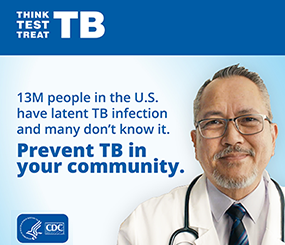At a glance
CDC Director Dr. Rochelle P. Walensky shares a message to colleagues on World TB Day, March 24, 2022 and describes how CDC is working to end TB in in the United States and around the world.
Dear Colleague Letters
March 24, 2022
Dear Colleagues,
World Tuberculosis (TB) Day provides an opportunity to inform people about the impact of TB around the world. We share successes in TB prevention and raise awareness of the challenges that continue to hinder our progress toward the elimination of this devastating disease. This is the third World TB Day we have observed amid the coronavirus disease 2019 (COVID-19) pandemic, and we continue to see the toll it takes on our domestic and global TB programs.
Although the United States has reported a record low number of cases, too many people still suffer from TB disease in this country. The COVID-19 pandemic has had a substantial effect on U.S. TB disease trends. In 2021, reported incidence in the U.S. increased 9.4 percent from a historic low in 2020 but remained 12.6 percent lower than the 2019 rate. The continued, substantial reduction from pre-pandemic levels raises concern for missed or delayed TB diagnoses. In addition, CDC estimates that up to 13 million people in the U.S. have latent TB infection, and without treatment, risk developing active TB disease in the future.
Around the world, nearly 2 billion people—a quarter of the world's population—are infected with TB bacteria and approximately 10 million people become ill each year with the disease. Though TB is preventable and treatable, it remains one of the world's deadliest infectious diseases, taking the lives of 4,100 people each day.

Faced with these challenges, CDC and partners have proven resilient and adapted services to sustain TB screening and treatment activities. In the U.S., CDC invests $80 million annually in health departments across the nation for TB prevention, control, and laboratory services. CDC leads a state-of-the-art national TB program and conducts clinical trials and epidemiologic research that contributes to new diagnostics, treatments, and approaches for eliminating TB. This year, CDC published guidance for a new treatment regimen for extensively drug-resistant TB disease and a shorter four-month regimen to treat drug-susceptible TB disease.
CDC is also engaging with communities disproportionately affected by TB through capacity-building efforts like the TB Elimination Alliance, and a new communications campaign Think. Test. Treat TB. aimed at raising awareness of TB prevention and promoting testing for and treatment of latent TB infection.
Our global efforts continue to focus on strengthening national TB strategies in priority countries with high rates of TB, drug-resistant TB, and TB/HIV co-infection. To sustain and expand TB activities during the COVID-19 pandemic, we adapted TB screening and treatment services, incorporating digital care strategies, multi-month dispensing of medicines, and services designed for individual community needs. As a result, CDC and its partners screened 9.5 million people with HIV for TB, nearly 62 percent of all people screened for TB in 2021, through the U.S. President's Emergency Plan for AIDS Relief (PEPFAR) and supported 1.6 million people living with HIV to complete TB Preventive Treatment.
CDC has partnered with the International Union Against Tuberculosis and Lung Disease to address the gap in diagnosis and treatment of TB among children. An estimated 63.5 percent of all children with TB are undiagnosed and untreated each year. Together, we established the Child and Adolescent Center of Excellence to build capacity and improve health worker skills to address pediatric TB in nine countries in Africa.
COVID-19 setbacks highlight the fragility of hard-won gains made recently towards global TB elimination targets. Unless TB prevention and treatment efforts are intensified, the United Nations' TB targets of treating 40 million people and providing TB preventative treatment to 30 million people will likely remain out of reach. But we have also learned a lot over the past few years—to innovate, to adapt, and to act boldly and decisively. By applying these lessons learned, we can make progress toward these global goals.
As an infectious disease physician, I know that timely diagnosis of TB disease saves lives and prevents the spread of TB in our communities. We must regain the momentum lost because of COVID-19 and accelerate progress in saving lives, reaching global TB targets, ensuring equitable access to TB services, and achieving our goal of eliminating TB.
Today, I encourage you to visit CDC's World TB Day and Global HIV and TB web sites to learn how you can help eliminate TB in your community. You can also view additional resources, testimonies from TB survivors, and success stories from domestic and global TB elimination champions.
Thank you for your continued commitment as we work together to eliminate TB in the United States and around the world.
Sincerely,
Rochelle P. Walensky, MD, MPH
Director, CDC, and
Administrator, ATSDR
